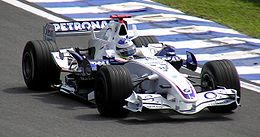
Back BMW Sauber F1.06 BS BMW Sauber F1.06 Czech BMW Sauber F1.06 German BMW Sauber F1.06 Spanish BMW Sauber F1.06 Finnish BMW Sauber F1.06 French BMW Sauber F1.06 Hungarian BMW Sauber F1.06 Armenian BMW Sauber F1.06 ID BMW Sauber F1.06 Italian
This article needs additional citations for verification. (July 2016) |
 Nick Heidfeld driving the F1.06 at the 2006 Brazilian Grand Prix | |||||||||
| Category | Formula One | ||||||||
|---|---|---|---|---|---|---|---|---|---|
| Constructor | BMW Sauber | ||||||||
| Designer(s) | Willy Rampf (Technical Director) Jacky Eeckelaert (Engineering Director) Christoph Zimmermann (Head of Chassis Design) Phil Arnaboldi (Head of Car Concept) Seamus Mullarkey (Head of Aerodynamics) Dirk de Beer (Principal Aerodynamicist) | ||||||||
| Predecessor | Sauber C24 | ||||||||
| Successor | BMW Sauber F1.07 | ||||||||
| Technical specifications[1] | |||||||||
| Chassis | carbon-fibre monocoque | ||||||||
| Suspension (front) | Upper and lower wishbones, inboard springs and dampers, actuated by pushrods | ||||||||
| Suspension (rear) | As front | ||||||||
| Length | 4,610 mm (181 in) | ||||||||
| Width | 1,800 mm (71 in) | ||||||||
| Height | 1,000 mm (39 in) | ||||||||
| Axle track | Front: 1,470 mm (57.874 in) Rear: 1,410 mm (55.512 in) | ||||||||
| Wheelbase | 3,110 mm (122 in) | ||||||||
| Engine | BMW P86 2.4-litre V8 | ||||||||
| Transmission | BMW Sauber 7-speed longitudinal | ||||||||
| Power | 760 hp @ 19,500 rpm[2][3] | ||||||||
| Weight | 600 kg (1,300 lb) (Dry weight including driver) | ||||||||
| Fuel | Petronas | ||||||||
| Lubricants | Petronas Syntium lubrication | ||||||||
| Tyres | Michelin | ||||||||
| Competition history | |||||||||
| Notable entrants | BMW Sauber F1 Team | ||||||||
| Notable drivers | 16. 17. 17. | ||||||||
| Debut | 2006 Bahrain Grand Prix | ||||||||
| Last event | 2006 Brazilian Grand Prix | ||||||||
| |||||||||
| Constructors' Championships | 0 | ||||||||
| Drivers' Championships | 0 | ||||||||
The BMW Sauber F1.06, also simply known as the BMW F1.06, was the car with which the BMW Sauber team competed in the 2006 Formula One World Championship. It was driven by German Nick Heidfeld, who joined from Williams, and Canadian Jacques Villeneuve, who had spent one season with Sauber before it was bought by BMW. However, Villeneuve was replaced by third driver, Pole Robert Kubica, before the season finished. The year marked the first time that BMW had competed as a full team; previously it had only supplied engines. The chassis was designed by Willy Rampf, Jacky Eeckelaert and Seamus Mullarkey with the powertrain being designed by Heinz Paschen.
This was the first V8-powered Hinwil-based Formula One car since the Sauber C14 in 1995.
- ^ Constanduros, Bob (2006). "Formula 1 Review: BMW Sauber F1 Team". Autocourse 2006–2007. Crash Media Group. pp. 76–78. ISBN 1-905334-15-X.
- ^ "Current Engine Ranking??? - Racing Comments Archive".
- ^ "Engine BMW • STATS F1".